
Cryptocarya is a genus of evergreen trees belonging to the laurel family, Lauraceae. The genus includes more than 350 species, distributed through the Neotropical, Afrotropical, Indomalayan, and Australasian realms.

Cryptocarya erythroxylon is a medium to large rainforest tree, that grows from the Barrington Tops in New South Wales to the Gladstone area in Queensland. The common name is the pigeonberry ash, rose maple, or rose walnut.
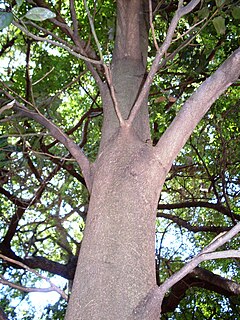
Cryptocarya foetida is a rainforest tree growing at the eastern coastal parts of Australia. The common name is due to the allegedly offensive odour given by the flowers. The stinking cryptocarya or stinking laurel is considered vulnerable to extinction with a ROTAP rating of 3VC.

Cryptocarya rigida is a small tree or shrub growing in high rainfall areas in north eastern New South Wales, Australia. It was described in 1864 by Carl Meissner in Prodromus Systematis Naturalis Regni Vegetabilis. Extinct in the Illawarra region, allegedly seen in the Illawarra in 1818 by Allan Cunningham.
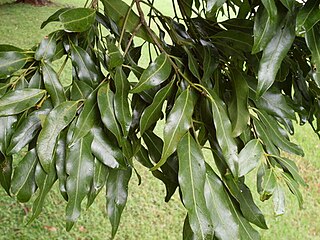
Cinnamomum oliveri is a rainforest tree growing at the eastern coastal parts of Australia. It grows from the Illawarra district in New South Wales to Cape York Peninsula at the northern tip of Australia. The southernmost limit of natural distribution is on the volcanic cliffs above the town of Gerroa and nearby on the sand in rainforest behind Seven Mile Beach, New South Wales.

Cryptocarya glaucescens, commonly known as jackwood, is a rainforest tree of the laurel family growing in eastern Australia.

Endiandra sieberi, known as the corkwood is a rainforest tree growing in eastern Australia.

Cryptocarya obovata is a large laurel growing on basaltic and fertile alluvial soils in eastern Australian rainforests. It is found from Wyong in New South Wales to Gympie in the state of Queensland. Extinct in the Illawarra region, allegedly seen in the Illawarra in 1818 by Allan Cunningham. The species was included in the Prodromus Florae Novae Hollandiae et Insulae Van Diemen, 402 (1810)
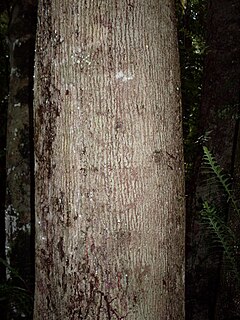
Emmenosperma alphitonioides, the yellow ash or bonewood, is a rainforest tree of eastern Australia. It grows from Clyde River, New South Wales near Batemans Bay, to Cape York Peninsula in at the most northerly part of Australia. It grows in many different types of rainforest, in tropical, sub tropical and warm temperate rainforests.

Cryptocarya laevigata, known as the glossy laurel or red-fruited laurel, is a rainforest plant growing in eastern Australia. The natural range of distribution is rainforest understorey on fertile soils, from the Richmond River, New South Wales to Cairns in tropical Queensland. Often seen in association with the White Booyong.

Cryptocarya foveolata, known as the mountain walnut is a rainforest tree growing at high altitude in eastern Australia. Despite the common name, it belongs to the laurel family.

Backhousia leptopetala is a common Australian tree, growing from Stanwell Park in the northern Illawarra district to near Buderim in south eastern Queensland.

Cryptocarya triplinervis is a rainforest tree growing in eastern Australia. Common names include the three veined laurel, three veined cryptocarya and the brown laurel.

Cryptocarya meissneriana, known as the thick-leaved laurel is a small tree growing in eastern Australia. The habitat is rainforest on the poorer sedimentary soils.

Croton verreauxii known as the green native cascarilla is a small tree or shrub growing in dry rainforest and rainforest margins in eastern Australia.

Endiandra discolor is an Australian tree, growing from near Gosford, New South Wales to Tully, Queensland in the tropics. Common names include rose walnut and domatia tree.

Cryptocarya bidwillii, the yellow laurel, is a small to medium-sized tree in the laurel family. Occurring in Australian rainforests from Nymboida in the state of New South Wales to Townsville in tropical Queensland. Often found in the dryer ridges in dry rainforest or in viney scrubs.
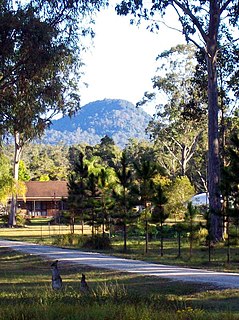
Cryptocarya floydii is an Australian rainforest tree. It occurs in steep dry rocky gullies in northern New South Wales and adjacent areas in Queensland as far north as Bunya Mountains National Park. It grows as far south as the upper gullies of the Guy Fawkes River and the Macleay River. The common name is gorge laurel or Glenugie laurel, after the type locality of Glenugie Peak, near Grafton, New South Wales.

Cryptocarya nova-anglica, the mountain laurel, is a rainforest tree growing in eastern Australia. The habitat is a restricted distribution in cool temperate rainforest mostly over 1,100 metres in altitude. The range of natural distribution is from the upper Hastings River to near the border of the state of Queensland. It is an understorey tree, associated with the Antarctic beech, possumwood, golden sassafras and black olive berry trees.
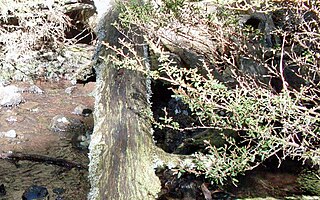
Leptospermum polygalifolium subsp. montanum known as the mountain tea tree or tantoon is a shrub or small tree found in eastern Australia. The original specimen was collected in 1912 near Yarrowitch. This plant is a sub-species of the Tantoon of the Myrtle family. It resembles other plants commonly referred to as "tea trees" or "paperbarks". The sub-species term montanum refers to its habitat of high altitudes. Polygalifolium is derived from Latin, referring to the resemblance of the leaves to certain members of the Polygala.





















